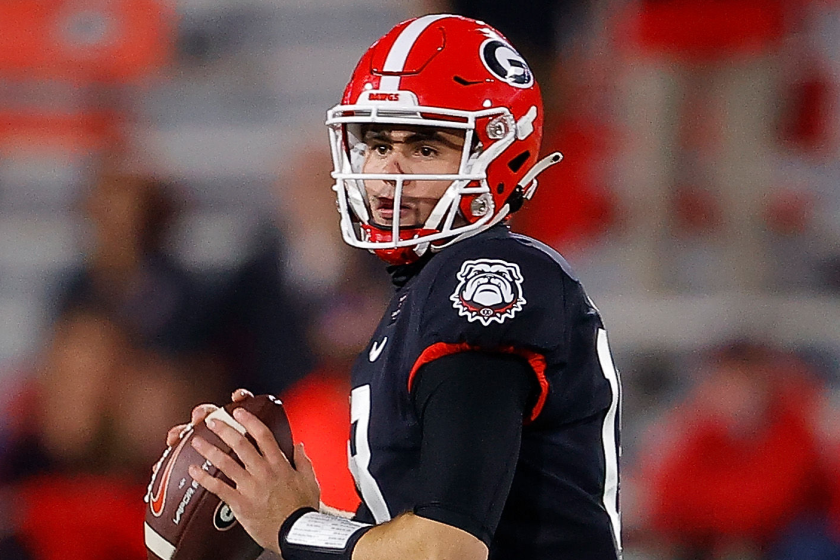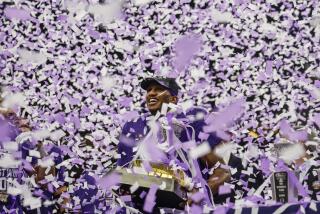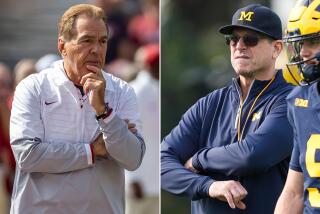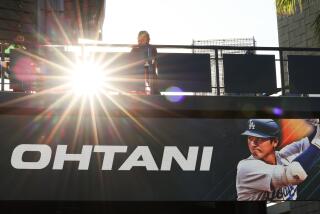Commentary: College football quickly learned how to protect revenues by risking player safety
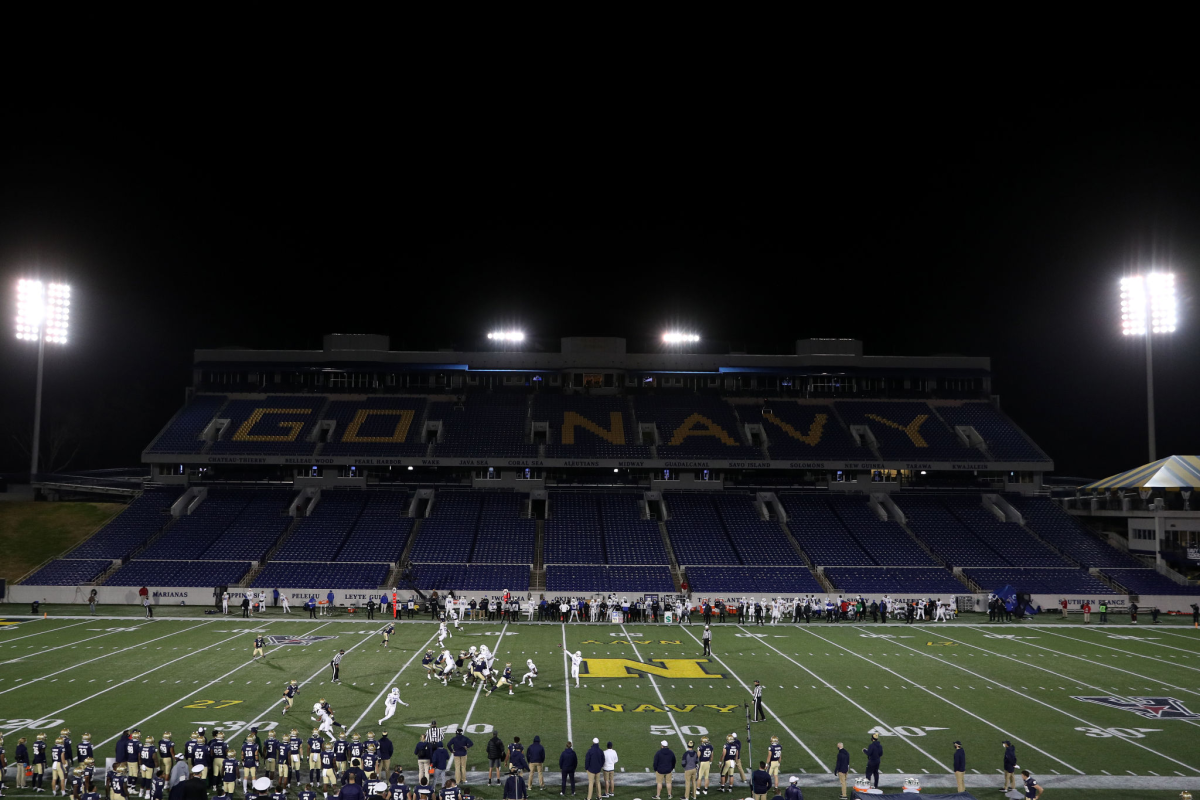
- Share via
Through Thanksgiving weekend, the people who put on the Sun Bowl annually on New Year’s Eve were hopeful they could have a game this year.
It would be different, sure. The teams would come into El Paso for only a night or two, and the players basically wouldn’t leave their hotels, creating a bubble atmosphere. There would be no festive team dinner at the Cattleman’s Steakhouse, or an educational trip to Ft. Bliss military base, or the usual fun at Topgolf. The point would be to stage a football game in front of few fans and only for the national television audience on CBS, and the Pac-12 and Atlantic Coast conferences told Sun Bowl executive director Bernie Olivas they were fine with that arrangement.
Everything was pushing ahead toward two lucky athletic departments splitting the $4.7-million pot for participating in the game — until Olivas and the bowl’s board opened their eyes and began to look around. El Paso is one of many COVID-19 hotspots nationwide, with 37,000 active cases and a death count nearing 1,000.
Monday, the Sun Bowl decided it was tapping out of the game.
“We’re using our convention center as part hospital and bringing in mobile morgues … we want to have a football game in the middle of this? We can do a lot better for our community,” Olivas said. “The last thing we want is for someone to come here and somehow pick up the virus at our football game, go home and spread it, and it’s traced back to the Sun Bowl game. It would be hard for us to live with that.”
Since retiring from the U.S. Women’s National Team, Rachel Buehler Van Hollebeke has gone from the soccer pitch to the ICU as a doctor fighting COVID-19.
Added John Folmer, the bowl’s football committee chairman who has been working with the game for 50 years, “The possibility of exposing just one fan or student-athlete to this disease, that’s why we made this decision.”
Sadly, in the scope of the 2020 college football season, it felt like an isolated occurrence.
Finally, somebody just said no on their own, without having their hand forced by state or local regulations. Finally, somebody wasn’t saying they were operating “out of an abundance of caution” while simultaneously searching desperately for the next chance to get unpaid athletes onto television screens wearing school colors that blend to create a false sense of normality for viewers.
Folmer looked to be in pain that his beloved bowl game had to be canceled but felt “we’re doing what’s right at the end of the day.” Meanwhile, by week’s end, the Pac-12 announced it had found a new bowl partner for this year in the Lockheed Martin Armed Forces Bowl in Fort Worth.
It’s amazing now looking back at the news conference in late September when the Pac-12 announced it was restarting a fall season. Oregon President Michael Schill, the chair of the league’s CEO Group, said that if it became clear that it if wasn’t working they would pull the plug.

Through four weeks, nine originally scheduled games were canceled — 38% — and three replacement games created on the fly. Arizona State had not played since Week 1 because of a major outbreak within its program until Saturday.
Stanford, due to Santa Clara County’s latest COVID-19 rules, can’t play football anymore on the Farm, so the Cardinal relocated to the Pacific Northwest for the last two weeks of the season to get in games at Washington and Oregon State.
If USC and Washington State play Sunday it will be the first weekend the Pac-12 was able to stage six games.
Combine all of that hassle with the pandemic situation worsening, and it’s obvious there was nothing that was going to stop this money train once it got rolling.
Sunday would normally be the day the College Football Playoff announced its four-team field and set the other New Year’s Six bowl matchups, allowing for the rest of the bowls to send their invitations. Instead we’ve got two more weeks of December drudgery, with the playoff selection committee insisting on ignoring travel advisories at the height of this pandemic’s third wave to meet in person because they feel they can’t have proper debate about how to seed Alabama, Notre Dame, Clemson and Ohio State over Zoom.
What exactly are we doing here? What is it, really, that we are watching? The most brazen example yet that this system is broken for the “student-athletes” it is meant to serve.
::
In the spring, when the fall semester was still months away and college administrators could dream of a more subdued virus, many including NCAA President Mark Emmert publicly stated that you could not have college athletes playing their sport unless they were joined on campus by their fellow students.
This backed up a core tenet of the NCAA, especially as it defends amateurism in lawsuits and in the court of public opinion — that college athletes are treated the same as their nonathlete peers and therefore should not be considered employees of the school.
Panic ensued in late May when the California State University system announced that its 23 campuses would all be learning virtually in the fall. That meant that Football Bowl Subdivision schools San Jose State, Fresno State and San Diego State, which make up a quarter of the Mountain West Conference, would be in jeopardy of not being able to play football.
Fresno State provided the first glimpse of how university presidents with real athletic pressures would respond for the rest of 2020, clarifying in a statement that “schools and colleges are prioritizing in-person instruction for courses with academic outcomes that cannot be achieved virtually.” The logic went that if any students are on campus then college football players can be too.
“We feel like we can support them better, having them here,” said San Diego State athletic director John David Wicker, one of the first of many administrators and coaches to make that assertion in the coming months.
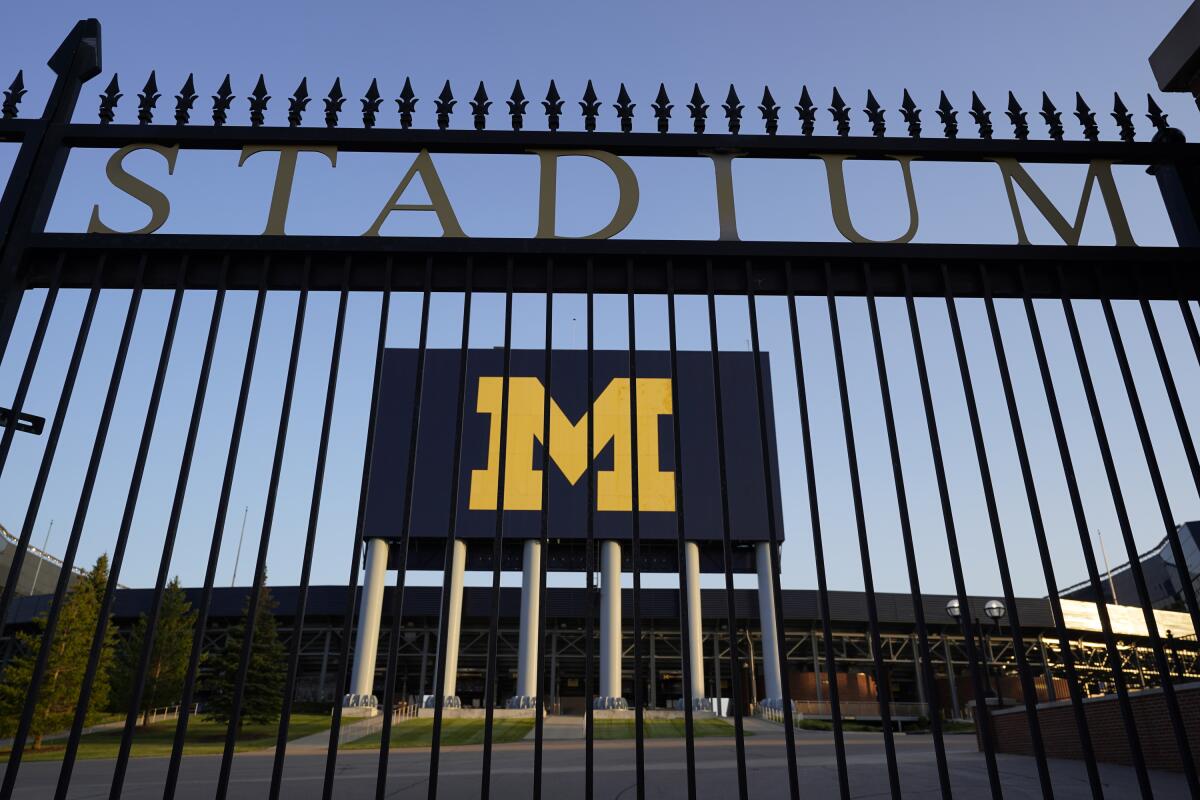
If Mountain West schools were digging their cleats in, then certainly Power Five schools would do the same.
A summer of social unrest followed, sprouting a movement of Pac-12 football players who banded together under #WeAreUnited in early August and threatened to boycott the season unless their demands were met. They asked for enforceable health and safety protocols, the ability to keep their scholarship if they opted out of playing the season and 50% of revenue from a 2020 season, among other wishes. Soon after, a group of Big Ten Conference players formed College Athlete Unity and requested their own health and safety standards.
Within days, the Big Ten and Pac-12 announced they were postponing their seasons, citing concerns about myocarditis, an inflammation of the heart that was showing up in COVID-19 patients, and a lack of testing capacity to play the season safely.
There was no mention of the player movements, but university presidents’ discomfort with college athletes organizing need not be acknowledged.
A month later, the Big Ten and Pac-12 came back to life, trumpeting daily testing and the ability to perform deeper analysis of the hearts of players who test positive.
A torn ACL derailed JT Daniels’ promising career at USC, but he didn’t let adversity block his rise to the top of a crowded quarterback room at Georgia.
“This is something they dream of, this is something that they want for their future,” Oregon’s Schill said then. “COVID-19 has taken so much away from these students. I didn’t want to take this away from them.”
There has been so much talk of how great it is that college football players have been provided the opportunity to play the game they love during this crisis. But why is it so important to universities that this population of the student body gets to congregate and pursue its passions?
Across the country, there are theater majors who can’t perform in the annual play production, orchestra members who can’t make beautiful music, student journalists who can’t gather to make decisions about what goes on tomorrow’s front page. So much has been taken away from them too, and yet those students aren’t going to receive an extra year of eligibility to make up for it like the athletes who actually got to participate this fall.
The reason, of course, is that every time a Power Five football game ends up on television, the schools get a couple of million dollars back in their depleted coffers.
“It’s absolutely remarkable you could say, ‘For the safety of our students we’re closing our classrooms but opening up our football fields.’”
— Bill Isaacson, an antitrust litigator and plaintiffs’ attorney in the O’Bannon v. NCAA trial of 2014
If there’s one good thing that comes from this season, it’s that the NCAA should never be able to successfully defend amateurism in court again.
“You don’t get a starker illustration of the hypocrisy than they are operating just like a big business who needs this revenue and so the students go home and get their education from home and the football and basketball players stay and play their games for television,” said Bill Isaacson, an antitrust litigator and plaintiffs’ attorney in the O’Bannon vs. NCAA trial of 2014.
“The NFL is professional, and those players are making adult decisions and sharing in the benefits of that. But the college players get cut out. Amateurism just means that [players] are not sharing in the revenues of the business. It’s absolutely remarkable you could say, ‘For the safety of our students we’re closing our classrooms but opening up our football fields.’ ”
2020 will go down as the year college football players became full-on TV entertainers, only they did not have a guild to collectively bargain for their interests.
::
Even if one can look past the uncomfortable truths that have been revealed by this pandemic season and make it to your sofa on Saturday, the 2020 slate hasn’t been able to deliver the glorious distraction we’ve come to expect week in and week out.
College football fans were robbed of intersectional matchups like USC-Alabama, Michigan-Washington and Ohio State-Oregon due to teams playing only within their conferences. Staggered starts — the ACC and Big 12 began Sept. 12, the SEC Sept. 26, the Big Ten Oct. 24 and the Pac-12 Nov. 7 — led to staggered national interest.
Plus, the never-ending news cycle of the pandemic and the election has eaten up attention spans. Within an hour of the Pac-12’s inaugural 9 a.m. kickoff between USC and Arizona State on Nov. 7, the cable news networks began to call the election for Joe Biden.
“You were talking about a 200% spike in cable news network coverage,” said Austin Karp, the managing editor for digital at Sports Business Daily. “Fox and the Pac-12 wanted to get an indicator as to how that morning game would perform on the West Coast, and you had to toss that all out.”
A 28-27 USC win that featured a furious comeback in the final minutes got 2.3 million viewers, down 9% from last year’s Pac-12 average on Fox, Karp said. Last weekend, UCLA-Arizona on Fox was down 46%, and Texas Tech-Oklahoma State down 42%.
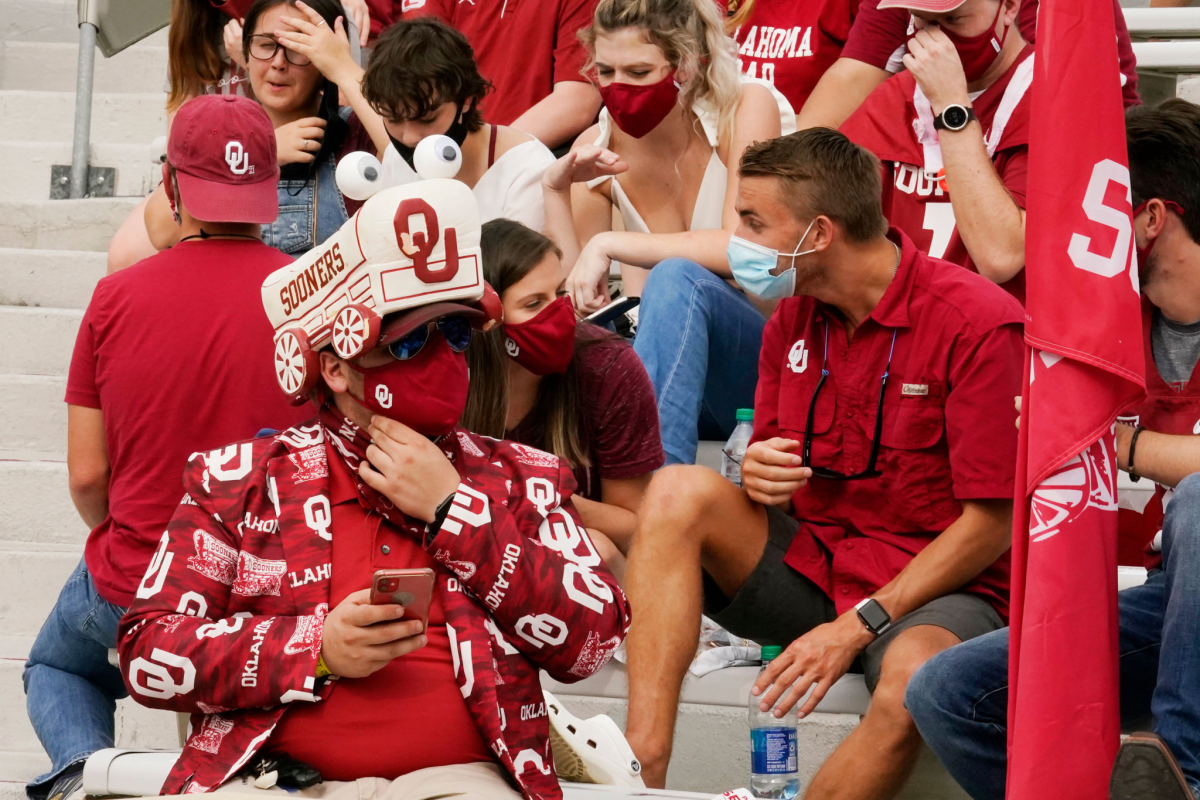
“Before the election, college football was down somewhere close to 30% across the board,” Karp said. “It’s pretty bad out there. People can’t even keep track of who’s playing.”
This weekend, the only top-25 matchups were No. 12 Indiana-No. 16 Wisconsin and No. 13 Brigham Young-No. 18 Coastal Carolina — a game that wasn’t scheduled until the middle of the week when Liberty had to bow out of the Coastal game because of COVID concerns. The Cougars and Chanticleers both have 9-0 records, a great story to be sure, but that probably didn’t move the needle for the average viewer.
It doesn’t help that no fresh contender has broken into the playoff’s projected top four either. Only a Florida upset of Alabama in the SEC championship game or a Notre Dame win over Clemson in the ACC championship game is likely to dislodge a playoff consisting of No. 1 Alabama, No. 2 Notre Dame, No. 3 Clemson and No. 4 Ohio State. The Buckeyes are 5-0, having missed two contests due to COVID, and are just hoping to get two more games in before the CFP is picked Dec. 20.
There will be plenty of debate about Ohio State with a 6-0 or 7-0 record getting in over a team like No. 5 Texas A&M if the Aggies make it to 8-1 or 9-1, but college football’s postseason has long been defined by subjective criteria, and we can’t forget that part of the reason the Big Ten attempted this season was to quiet Ohio State’s whining about not getting its coveted title shot.
Marv Marinovich, who helped USC football capture a national title in 1962 before his son went on to become a star quarterback for the Trojans, has died at 81.
College football is uniquely set up to manage any chaos down the stretch. A national champion will be crowned, and hundreds of millions of dollars in media rights money recouped.
Many teams will travel one more time as the pandemic’s third wave crests to play in bowl games that will sequester them to their hotels. The trademark hospitality of the bowl system will be limited in some cases to making sure the players have more entertaining options for their game rooms.
Last week, Fiesta Bowl executive director Mike Nealy said he hoped that schools wouldn’t allow their players to go home for the Christmas holiday.
“As you know if students are dispersed and then coming back, there’s just a higher probability of infection, and we’re just running the risk,” Nealy said.
Without knowing it, he confirmed college football’s new motto: Keep the players safe, keep the revenues safer.
More to Read
Go beyond the scoreboard
Get the latest on L.A.'s teams in the daily Sports Report newsletter.
You may occasionally receive promotional content from the Los Angeles Times.

